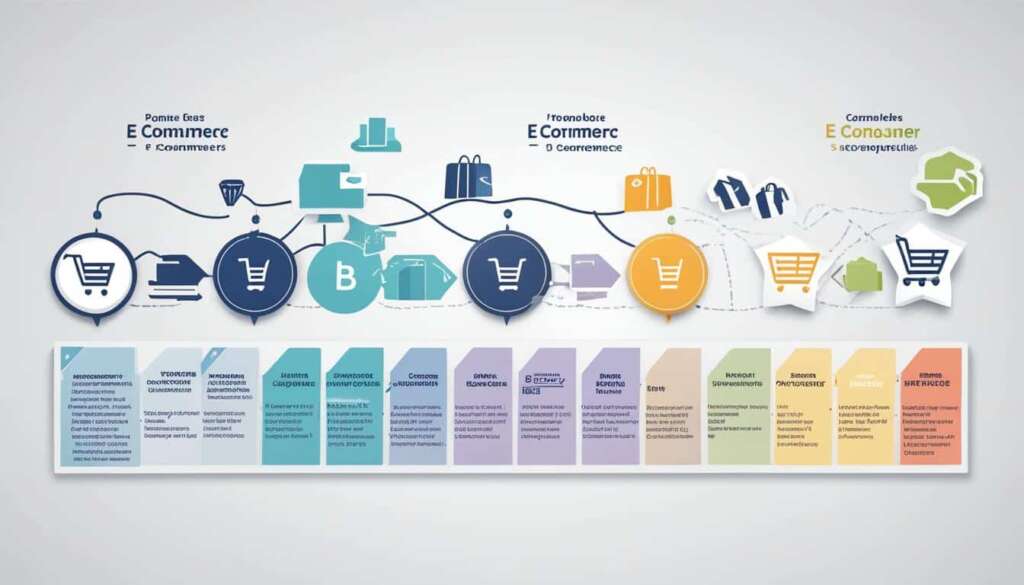Table of Contents
Welcome to our comprehensive guide on mean e-commerce and its significance in achieving online business success. In today’s digital age, e-commerce has revolutionized the way we buy and sell goods and services. From small businesses to global retail giants, e-commerce has become a vital component of the global economy.
E-commerce, short for electronic commerce, encompasses various online transactions, including business-to-business (B2B), business-to-consumer (B2C), consumer-to-consumer (C2C), and consumer-to-business (C2B). Platforms like Amazon and eBay have played a significant role in the growth of e-commerce, with its market share increasing from 5% of total retail sales in 2011 to a staggering 16.5% in Q2 2020, predominantly due to the impact of the COVID-19 pandemic.
So, what makes e-commerce so appealing? It offers numerous advantages, such as 24/7 availability, accessibility from anywhere with an internet connection, fast and convenient access to a wide range of products, and the ability to reach customers globally. These factors have contributed to e-commerce’s meteoric rise and are fundamental to establishing a successful online business.
How Does E-Commerce Work?
E-commerce revolves around the internet, enabling customers to access online stores using their devices. Once an order is placed, the customer’s web browser establishes communication with the e-commerce website’s server, initiating the process.
The order data is then transmitted to the order manager, which relays it to various databases responsible for inventory management, payment processing applications like PayPal, and the bank’s computer. This ensures a seamless flow of information throughout the entire order processing system.
“The success of e-commerce relies on the integration of various components, such as order management, inventory management, and payment processing.”
Upon validation, the order manager notifies the web server, which then sends an update to the customer, confirming that their order has been processed successfully. The data regarding the order is subsequently transmitted to the warehouse or fulfillment department, where the product or service is prepared for dispatch to the customer.
E-commerce encompasses a complex network of interconnected systems that collaborate to provide customers with a seamless shopping experience and businesses with efficient order processing and inventory management. This level of integration ensures that every step, from the initial online order to the final product delivery, is streamlined and efficient.
The E-commerce Workflow:
- Customer places an order on an e-commerce website using their web browser.
- The order data is transmitted to the e-commerce website’s server.
- The server forwards the order data to the order manager.
- The order manager relays the data to the inventory management system, payment processing applications, and the bank computer.
- After validation, the order manager sends a notification to the web server.
- The web server updates the customer on the order status.
- The order data is sent to the warehouse or fulfillment department.
- The product or service is prepared for dispatch.
- The product or service reaches the customer.
Understanding how e-commerce operates is essential for both customers and businesses. From the customer’s perspective, it allows them to confidently navigate online stores and place orders with ease. For businesses, comprehending the intricate workflow of e-commerce enables them to effectively manage order processing, inventory, and customer satisfaction, ultimately contributing to their online success.
Types of E-Commerce
E-commerce encompasses various types of online transactions, each involving different parties. Understanding these types can provide insights into how businesses interact and sell their products or services in the digital marketplace.
B2B E-Commerce
B2B e-commerce focuses on transactions between businesses. This type of e-commerce involves the exchange of products, services, or information between two or more companies, facilitating efficient B2B collaboration and supply chain management.
B2C E-Commerce
B2C e-commerce refers to businesses selling their products or services directly to consumers. It encompasses the online stores and marketplaces where consumers can purchase items from a wide range of retailers, creating a seamless shopping experience.
C2C E-Commerce
C2C e-commerce enables consumers to trade products, services, and information with each other. Online platforms provide individuals with the opportunity to buy and sell products directly, promoting a peer-to-peer marketplace where trust and user reviews are vital.
C2B E-Commerce
C2B e-commerce allows consumers to make their products or services available for businesses to purchase. This type of transaction is often seen in freelance marketplaces, where individuals offer their skills or expertise to businesses seeking specific services.
Other Types of E-Commerce
In addition to B2B, B2C, C2C, and C2B e-commerce, there are other types of online transactions. These include business-to-administration (B2A) e-commerce, involving transactions between companies and government bodies. Consumer-to-administration (C2A) e-commerce refers to transactions between individuals and public administration or government bodies, such as online tax filing or bill payment.
Understanding the different types of e-commerce is essential for businesses to tailor their strategies, target the right customer base, and maximize their online presence.
Advantages of E-Commerce
E-commerce offers several advantages that contribute to its widespread popularity and success in the modern business landscape. These benefits encompass the crucial areas of availability, accessibility, speed of access, wide selection, and international reach. By leveraging these advantages, businesses can harness the potential of e-commerce to drive growth and profitability.
Around-the-clock Availability: One of the key benefits of e-commerce is the ability to provide customers with round-the-clock access to products and services. Unlike traditional brick-and-mortar stores with limited operating hours, e-commerce platforms are available 24/7, allowing customers to browse and shop at their convenience.
Speed of Access: E-commerce platforms enable swift and seamless access to product pages, information, and the checkout process. By leveraging advanced web technologies and optimized infrastructure, e-commerce websites ensure that customers can navigate through different sections of the platform and complete their purchases quickly and efficiently.
Wide Selection: Another advantage of e-commerce is the vast array of products and services available to customers. Online stores can stock an extensive range of merchandise, catering to diverse needs and preferences. This wide selection empowers customers to find precisely what they desire, even niche or specialized items that may not be readily available in physical stores.
International Reach: E-commerce transcends geographical boundaries, enabling businesses to reach customers around the globe. This international reach expands a business’s customer base beyond the limitations of physical store locations, unlocking opportunities for growth and increased revenue streams.
Cost Efficiency: E-commerce businesses can benefit from significant cost savings compared to traditional retail operations. By eliminating expenses such as rent, utilities, and physical storefront maintenance, online retailers can allocate resources more strategically, maximizing profitability and reinvesting in business growth initiatives.
Personalization and Product Recommendations: E-commerce platforms effectively leverage customer data to offer personalized experiences and targeted product recommendations. By analyzing customers’ browsing and purchasing patterns, online retailers can create tailored shopping experiences, enhancing customer satisfaction and driving repeat business.
“E-commerce has revolutionized the way businesses operate and interact with customers, offering a plethora of advantages that contribute to its growing dominance in the retail industry.” – E-commerce Expert
E-commerce’s inherent benefits have played a significant role in its ever-increasing popularity and global adoption. By embracing e-commerce, businesses can tap into the advantages of availability, accessibility, speed, selection, and international reach, positioning themselves for success in the digital age.
Comparison Table: Traditional Retail vs. E-Commerce
| Factors | Traditional Retail | E-Commerce |
|---|---|---|
| Availability | Operating hours restrict accessibility | 24/7 availability for customers |
| Geographical Limitations | Physical store locations limit reach to local customers | Global access to customers worldwide |
| Setup and Maintenance Costs | Higher costs for physical storefronts | Lower costs with no need for physical space |
| Product Selection | Limited by physical store space | Wide range of products available |
| Personalization | Limited ability to personalize shopping experiences | Customized experiences based on customer data |
By comparing traditional retail and e-commerce, we can clearly see how e-commerce’s advantages surpass the limitations of traditional retail models. From 24/7 availability and global reach to a wide selection of products and personalized experiences, e-commerce has revolutionized the retail industry, shaping the way businesses operate and customers shop in the modern digital era.

Disadvantages of E-Commerce
E-commerce, despite its numerous advantages, also comes with certain drawbacks. It is important for businesses and consumers alike to be aware of these disadvantages to make informed decisions. Let’s explore some of the key challenges associated with e-commerce.
Limited Customer Service
One of the primary concerns with e-commerce is the limited availability of customer service. Online stores often have limited support options or specific support hours, which can be frustrating for customers seeking real-time assistance. This lack of personalized interaction may hinder the overall customer experience and lead to decreased satisfaction levels.
Inability to See/Touch Products
Another disadvantage of e-commerce is the inability to physically see or touch products before making a purchase. Unlike traditional brick-and-mortar stores, where customers can examine products firsthand, online shoppers have to rely solely on product images and descriptions. This limitation can make it challenging to assess the quality, size, or functionality of a product accurately.
Shipping Wait Time
E-commerce introduces a delay in receiving purchased items due to shipping. Unlike physical stores where customers can obtain products immediately, online purchases often require shipping and delivery time. Depending on the location, shipping wait times can vary, and delays may occur. This aspect of e-commerce can be inconvenient for those seeking instant gratification or urgently needed products.
Security Issues
Security concerns are a significant disadvantage of e-commerce. With the proliferation of online transactions, the risk of fraudulent websites and payment data breaches has increased. Online shoppers must remain vigilant and ensure they are engaging with reputable and secure websites. The potential threat to personal and financial information can deter some individuals from embracing e-commerce fully.
Despite these disadvantages, the convenience and accessibility of e-commerce continue to attract millions of customers worldwide. By understanding and mitigating these challenges, businesses can strive to provide a seamless online shopping experience while maintaining customer trust and satisfaction.
The Rise of E-Commerce
E-commerce has experienced significant growth in recent years, and the COVID-19 pandemic has further accelerated its rise. In 2019, global e-commerce retail sales reached over $365 billion, and this figure is predicted to continue increasing. The fear of infection and lockdown measures caused more people to shift their shopping online, resulting in a surge in online retail sales. Notably, mobile commerce accounted for over 50% of online transactions, indicating the increasing use of smartphones and tablets for online shopping.
Online marketplaces like Amazon have become dominant players in the e-commerce industry, offering a wide range of products and services to customers. These platforms provide convenient and inclusive shopping experiences for consumers worldwide. As a result, the global e-commerce value has seen remarkable growth.
The value of global e-commerce retail sales is projected to reach an astonishing $4.88 trillion in 2021. This exponential increase in e-commerce sales highlights the growing importance and impact of online retail in the global economy. E-commerce has transformed the way businesses operate and consumers shop, offering convenience, accessibility, and a wider selection of products.
Despite the challenges posed by the pandemic, the e-commerce industry has proven to be resilient and adaptable. As more consumers embrace online shopping, businesses must adapt to meet their evolving needs and preferences. The rise of e-commerce presents significant opportunities for businesses to expand their customer base, international reach, and overall revenue.
Essential Elements for Successful E-Commerce
To build a successful online retail business, merchants must master several essential elements. These include:
- Creating a Strong Brand Identity: A strong brand identity is crucial for standing out in a competitive e-commerce landscape. It involves developing a unique brand personality and values that resonate with the target audience. By effectively communicating the brand’s story, mission, and values through branding elements like logos, color schemes, and messaging, businesses can establish a strong and recognizable brand identity.
- Designing a User-Friendly Website: A user-friendly website is pivotal in providing a seamless and enjoyable shopping experience for customers. It should have intuitive navigation, clear product categories, and search functionality that allows users to easily find what they’re looking for. Additionally, organizing products with concise and compelling descriptions, accompanied by high-quality product images, helps customers make informed purchasing decisions.
- Streamlined Checkout Process: A streamlined checkout process is essential for reducing cart abandonment and increasing conversion rates. It should be simple, secure, and quick, allowing customers to complete their purchase without unnecessary friction. Offering guest checkout and multiple payment options, as well as implementing trust indicators like SSL certificates, instills confidence in customers and encourages them to complete the transaction.
- Mobile-Friendly Website: With the majority of online traffic now coming from mobile devices, having a mobile-friendly website is imperative. Responsive web design ensures that the website adapts seamlessly to different screen sizes, providing optimal browsing experiences for users on smartphones and tablets. This enhances accessibility and allows customers to shop conveniently from any device.
- High-Quality Product Images: Compelling product images are crucial for capturing customers’ attention and showcasing vital details. High-resolution images that accurately represent the product from different angles, along with zoom and 360-degree view options, give customers a comprehensive understanding of the product’s appearance and features. This helps build trust and increases the likelihood of making a purchase.
- Encouraging and Managing Customer Reviews: Customer reviews play a significant role in building trust and credibility. Implementing a system that encourages customers to leave reviews and actively managing those reviews helps build a strong foundation of social proof. Responding to reviews, whether positive or negative, shows that the business values customer feedback and is committed to providing excellent customer service.
- Optimizing for SEO: Implementing SEO optimization techniques improves the visibility of the e-commerce website in search engine results, driving organic traffic and potential customers. This involves keyword research, on-page optimization, structured data markup, and building relevant backlinks. By optimizing the website’s content and structure, businesses can improve their search engine rankings and attract targeted traffic.
By mastering these essential elements, businesses can create a strong online presence, establish brand credibility, and provide a great user experience that leads to increased sales and customer satisfaction.
Conclusion
Understanding the essentials of mean e-commerce is crucial for building a successful online business. By leveraging the power of the internet, businesses can engage in various types of e-commerce transactions, cater to a global customer base, and reap the benefits of e-commerce, such as availability, accessibility, and wide selection.
However, it’s important to be aware of the potential disadvantages and challenges that come with e-commerce and take steps to mitigate them. Limited customer service, the inability to see or touch products before purchasing, shipping wait times, and security issues are some of the concerns that need to be addressed.
By mastering the essential elements of e-commerce, businesses can position themselves for success in the ever-growing digital marketplace. Creating a strong brand identity, designing a user-friendly and mobile-friendly website, featuring high-quality product images, managing customer reviews, and optimizing the website for SEO are all crucial steps in building a successful online business.
With the right knowledge and implementation of mean e-commerce essentials, businesses can achieve their goals and thrive in the competitive world of online commerce.
FAQ
What is e-commerce?
E-commerce, or electronic commerce, refers to the buying and selling of goods and services over the internet.
What are the four main types of e-commerce transactions?
The four main types of e-commerce transactions are business-to-business (B2B), business-to-consumer (B2C), consumer-to-consumer (C2C), and consumer-to-business (C2B).
How does e-commerce work?
When an order is placed on an e-commerce website, the customer’s web browser communicates with the website’s server. The order data is then forwarded to the order manager, which relays it to databases managing inventory levels, payment processing applications, and the bank computer. After validation, the order manager notifies the web server, and the customer is informed that their order has been processed. The order data is sent to the warehouse or fulfillment department, and the product or service is dispatched to the customer.
What are the advantages of e-commerce?
E-commerce offers advantages such as around-the-clock availability, accessibility, speed of access, wide selection, and international reach.
What are the disadvantages of e-commerce?
Some disadvantages of e-commerce include limited customer service, the inability to physically see or touch products before purchasing, shipping wait times, and security issues.
How has the COVID-19 pandemic impacted e-commerce?
The COVID-19 pandemic has accelerated the growth of e-commerce as more people shifted their shopping online due to fear of infection and lockdown measures. Mobile commerce has accounted for over 50% of online transactions, and online marketplaces like Amazon have become dominant players in the industry.
What are the essential elements for successful e-commerce?
Essential elements for building a successful online retail business include creating a strong brand identity, designing a user-friendly website with a streamlined checkout process, ensuring the website is mobile-friendly, featuring high-quality product images, encouraging customer reviews, and optimizing the website for search engine visibility and organic traffic.
What is the importance of understanding mean e-commerce essentials?
Understanding mean e-commerce essentials is crucial for building a successful online business. By leveraging the power of the internet and mastering the essential elements of e-commerce, businesses can engage in various types of transactions, cater to a global customer base, and reap the benefits of e-commerce.













